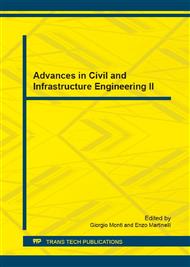[1]
KAUSEL E., ROËSSET J.M., Soil structure interaction for nuclear containment structures, Proceedings of ASCE, Power Division Speciality Conference, Boulder, Colorado, (1974).
Google Scholar
[2]
VELETSOS A.S., MEEK J.W., Dynamic behavior of building-foundation systems, Earthquake Engineering and Structural Dynamics 1974, 3: 121-138.
DOI: 10.1002/eqe.4290030203
Google Scholar
[3]
STEWART J.P., SEED R.B., FENVES G.L., Seismic soil-structure interaction in buildings I: Analytical aspects, Journal of Geotechnical and Geoenvironmental Engineering 1999a, 125: 26-37.
DOI: 10.1061/(asce)1090-0241(1999)125:1(26)
Google Scholar
[4]
STEWART J.P., FENVES G.L., SEED R.B., Seismic soil-structure interaction in buildings II: Empirical findings, Journal of Geotechnical and Geoenvironmental Engineering 1999b, 125: 38-48.
DOI: 10.1061/(asce)1090-0241(1999)125:1(38)
Google Scholar
[5]
GAZETAS G., Formulas and charts for impedances of surface and embedded foundations, Journal of Geotechnical Engineering 1991, 117: 1363-1381.
DOI: 10.1061/(asce)0733-9410(1991)117:9(1363)
Google Scholar
[6]
GEROLYMOS N., GAZETAS G., Static and dynamic response of massive caisson foundations with soil and interface nonlinearities-validation and results, Soil Dynamics and Earthquake Engineering 2006, 26: 377-394.
DOI: 10.1016/j.soildyn.2005.12.001
Google Scholar
[7]
MYLONAKIS G., NIKOLAOU S., GAZETAS G., Footings under seismic loading: Analysis and design issues with emphasis on bridge foundations, Soil Dynamics and Earthquake Engineering 2006, 26: 824-853.
DOI: 10.1016/j.soildyn.2005.12.005
Google Scholar
[8]
VARUN, ASSIMAKI D., GAZETAS G., A simplified model for lateral response of large diameter caisson foundations-Linear elastic formulation, Soil Dynamics and Earthquake Engineering 2009, 29: 268-291.
DOI: 10.1016/j.soildyn.2008.02.001
Google Scholar
[9]
DICLELI, M., LEE, J.Y., MANSOUR M., Importance of Soil-Bridge Interaction Modeling in Seismic Analysis of Seismic- Isolated Bridges, 13th World Conference on Earthquake Engineering, Vancouver, Canada, 2004, 3147.
Google Scholar
[10]
TSIGGINOS C., GEROLYMOS N., ASSIMAKI D., GAZETAS G., Seismic response of bridge pier on rigid caisson foundation in soil stratum, Earthquake Engineering and Engineering Vibration 2008, 7(1): 33-44.
DOI: 10.1007/s11803-008-0825-8
Google Scholar
[11]
COMPUTER AND STRUCTURES, Inc, CSI analysis reference manual. SAP 2000. Berkeley (CA), (2005).
Google Scholar
[12]
LAM I. P., LAW H., MARTIN G. R., Bridge Foundations: Modeling Large Pile Groups and Caissons for Seismic Design, Technical Report MCEER-07-0018, University at Buffalo, State University of New York.
Google Scholar
[13]
GEROLYMOS N., GAZETAS G., Winkler model for lateral response of rigid caisson foundations in linear soil, Soil Dynamics and Earthquake Engineering 2006, 26: 347-361.
DOI: 10.1016/j.soildyn.2005.12.003
Google Scholar


